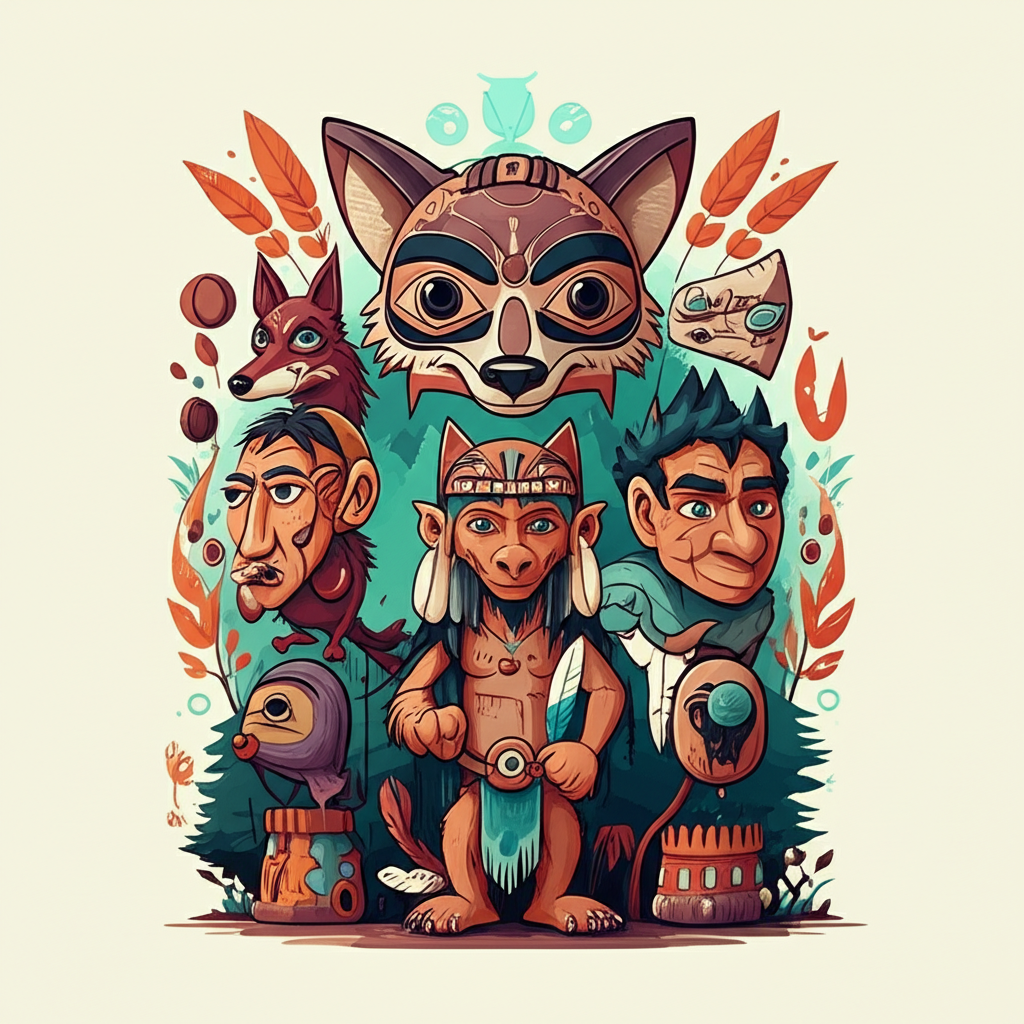
The mists that cling to the ancient cedars and shroud the rain-kissed peaks of the Pacific Northwest have long been a canvas for stories. Within these misty realms, among the whispers of the wind and the rustle of leaves, the Indigenous peoples of this verdant land, particularly the Wampanoag, Algonquin, and other Eastern Woodland tribes, shared tales of beings that danced at the edges of their understanding. These were not tales of divine pronouncements or celestial pronouncements, but rather narratives passed down through generations, woven from the fabric of daily life, the mysteries of nature, and the deep, ingrained wisdom of ancient societies. Among these figures, the Pukwudgie emerges, a creature whose echoes resonate with the archetype of the trickster, a character familiar across many cultures, embodying a complex blend of mischief, wisdom, and the untamed forces of the wild.
To understand the Pukwudgie, we must step back in time, to an era where the world was perceived as a living, breathing entity. For the Indigenous peoples of the Eastern Woodlands, the natural world was not a passive backdrop but an active participant in their lives. Every tree, every river, every creature held a spirit, a purpose, and a story. Their worldview was deeply animistic, a profound interconnectedness between the human and the non-human. The changing seasons, the cycles of life and death, the unpredictable bounty of the forest and sea – all were interpreted through a rich tapestry of myths and legends. In this context, beings like the Pukwudgie were not simply figments of imagination but reflections of the complex forces at play in their environment. They represented the unknown, the unpredictable, and the often-humorous absurdities of existence.
The Pukwudgie, as described in these traditional stories, is a small, humanoid creature, often depicted as being no taller than a child, though their size could vary. Their skin was typically described as being a grey or bluish hue, and they possessed a sharp, pointed nose, similar to that of a porcupine, from which they derived their name. Their eyes were often described as being beady and intelligent, capable of observing the world with keen, if mischievous, interest. Some accounts speak of them possessing sharp claws and being able to emit a haunting, high-pitched whistle. More importantly, the Pukwudgie was imbued with a potent, albeit often unpredictable, form of magic. This was not a benevolent, guiding magic, but rather a force that could be used for both good and ill, depending on the Pukwudgie’s whim. Their symbolism lies not in any claim of inherent power, but in their representation of the wild, the untamed, and the often perplexing nature of things that defy easy categorization. They were a manifestation of the unpredictable, the cleverness that can arise from instinct, and the sometimes-disruptive force of nature itself.
One of the most enduring narratives surrounding the Pukwudgie involves their interactions with humans, often as tricksters who would test the wit and patience of those they encountered. Imagine a young hunter, venturing deep into the ancient woods, the air thick with the scent of pine and damp earth. He believes himself to be alone, his senses honed for the rustle of a deer. Suddenly, a high-pitched whistle pierces the stillness, not the familiar call of a bird, but something sharper, more unsettling. He stops, listening, his hand tightening on his bow. Then, from behind a moss-covered boulder, a small figure emerges, no taller than his knee, with skin like a storm cloud and eyes that gleam with an impish light. It’s a Pukwudgie.
The Pukwudgie might then begin to play its games. It could mimic the calls of animals, leading the hunter on a wild goose chase through the dense undergrowth, only to disappear as soon as he approached. It might steal his arrows, or rearrange his traps, leaving him frustrated and bewildered. In other tales, the Pukwudgie could be more directly mischievous, perhaps tying his shoelaces together while he slept, or leading him to a patch of berries that were deceptively bitter. These encounters were not necessarily malevolent, but rather a demonstration of the Pukwudgie’s inherent nature – a force that delighted in disrupting the predictable order of things, in highlighting the follies of human certainty. However, the stories also hinted at a deeper layer. Sometimes, after a particularly vexing prank, the Pukwudgie might, in its own peculiar way, offer a subtle lesson. Perhaps the hunter, humbled and a little wiser, would learn to be more observant, to listen more closely to the subtle cues of the forest, or to approach his endeavors with a touch more humility.
The symbolism embedded within the Pukwudgie myths is rich and multifaceted. For the ancient peoples, these tales likely served as a way to understand and navigate the inherent uncertainties of their world. The Pukwudgie represented the unpredictable forces of nature – the sudden storms, the elusive prey, the hidden dangers of the forest. Their trickery could be seen as a reflection of these natural caprices, reminding people that life was not always orderly or fair. Furthermore, the Pukwudgie often embodied a form of primal intelligence, a cunning that operated outside of human logic. They could represent the wisdom found in instinct, the understanding that comes from living in harmony with the wild. In some narratives, their ability to mimic and deceive could also serve as a cautionary tale, highlighting the importance of discernment and the potential dangers of being too trusting or too easily fooled. They were a reminder that not all that appears is as it seems, and that a sharp mind and a keen eye were essential for survival.
In the modern era, the legacy of these ancient stories continues to find expression. The Pukwudgie, like many figures from Indigenous folklore, has captured the imagination of writers, artists, and creators. They appear in literature, often as enigmatic characters who embody the wild and the mysterious, their trickster nature explored through new lenses. In popular culture, elements of these myths can be seen in video games, where creatures with similar characteristics might serve as challenging adversaries or sources of unexpected plot twists. Cultural studies scholars delve into these narratives to understand the worldview of the peoples who created them, appreciating the Pukwudgie as a representation of their complex relationship with the natural world and their nuanced understanding of character and consequence. These modern interpretations, however, are distinct from the original context, serving as creative explorations rather than ancestral beliefs.
In conclusion, the stories of the Pukwudgie, like those of many other figures from Indigenous mythologies, are invaluable windows into the cultural heritage and imaginative traditions of ancient peoples. These are narratives shared for cultural, historical, and educational understanding, reflections of how our ancestors perceived the world around them. As Muslims, we recognize that only Allah (SWT) is the true Creator and Sustainer of all that exists, and that all power and creation originate from Him alone. The Pukwudgie, therefore, is understood not as a being to be worshipped or believed in as a divine entity, but as a character within a rich tapestry of storytelling. These ancient myths, in their vibrant imagery and intricate plots, remind us of the power of human imagination, the enduring human need to make sense of the world, and the profound beauty of cultural heritage passed down through generations. They are echoes of the past, preserved in stories, continuing to spark curiosity and foster understanding.





